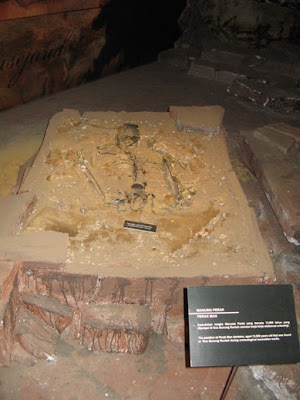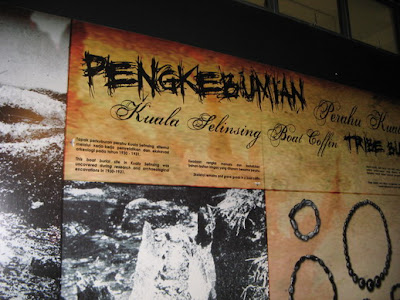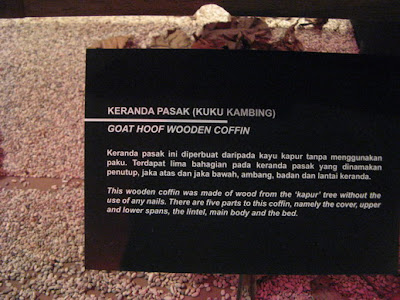STAR Weekend
Saturday July 3, 2010
Exploring the hidden depths
By LIZ PRICE
The Madai Cave proves to have interesting treasures outside, as well as inside.
To reach the main entrance to Madai Cave, you have to walk through a dark tunnel where there is a grave of an unknown person. None of the villagers know who was buried there.
Then you pop out of the tunnel and are surprised to see a cluster of wooden houses in front of the entrance. These belong to the nest collectors, the guardians of the cave.
Madai Cave is not as well known as the nearby Gomantong Caves in Sabah, or the caves in Gunung Mulu National Park in Sarawak. However, Madai has long been an important site for the birds’ nest collectors and is slowly becoming better known to tourists who are looking for adventure.
Leisurely life: A young villager does what comes naturally to him, chill.
Situated between Lahad Datu and Tawau, the hill containing Madai Cave rises steeply from the forest floor. It can be seen from far away, and you get tantalising views of it standing above the oil palm plantations. The final approach is interesting as you drive down a steep hill into the kampung.
A collection of wooden houses line both sides of the road, and the cliff acts as a scenic backdrop. You can see the gaping mouth of the cave from here. There is little activity in the village, except for women carrying buckets walking to and from the river to do the washing.
As we were on a research trip, we already had a guide arranged. We followed him along the narrow path between the houses. I was surprised to turn a corner and see a new mosque in the centre of the village. A collection of children appeared from the various houses, curious to see the Mat Salleh (Caucasian) visitors in their village.
However, none actually followed us up the staircase to the cave tunnel.
We assembled at the houses outside the main upper entrance. Washing was hanging out to dry, and there were wooden tables and benches in the central area. There is also another grave. This one supposedly belongs to Nenek Apui, who was one of the earliest inhabitants here.
There are more than 25 caves in this area, but Madai is the biggest and best known. It has a long history. The caves were first visited by scientists 60 years ago. They reported that the phosphate deposits from the bat and swiftlet guano were collected for use as fertiliser. However, a far older industry is birds’ nest collection. The local Idahan people have had the rights for collecting for many generations.
One of the houses near the Madai Cave.
The harvesting of birds’ nests is a well-known industry throughout Borneo. There are many limestone caves which are home to the swiftlets that build the edible nests. And nowadays, swiftlet farming is becoming a big business, whereby existing buildings are converted in “bird hotels”, and in some places new purpose-built structures are being constructed.
There is an ever increasing demand for birds’ nests for the culinary and medicinal markets.
In Madai, the collection is controlled by the villagers who own the rights. The houses at the cave entrance are mainly used during the collecting seasons. The locals are the guardians of the birds’ nests and use the buildings for sleeping and for guarding the caves to keep out unauthorised people.
Walking into the cave, I was struck by how big it was.
The ceiling is really high, maybe 130m, and the chambers are large. There are several openings high in the roof which allow a small amount of daylight to enter.
The boardwalk soon ended, and we were walking in guano. It was really quite slippery walking across these sticky, wet droppings, deposited by bats and birds. If you didn’t watch every step, it was easy to sink ankle-deep in this gooey waste.
And there were lots of small cockroaches running around in the guano, feeding on smaller invertebrates. Quite often, I had to brush them off my legs as they climbed up. All around I could hear the clicking of the swiftlets and chirping of insects.
There were a few swiftlets on the floor, and although they presented a good photo opportunity, it was sad to know they would not survive.
But in turn they would help to support the food chain within the cave.
I was quite surprised at the number of men inside the cave, considering it wasn’t yet collecting season. The collection is controlled and restricted to twice a year so as not to deplete the swiftlet population. There were few ladders hanging in the cave, but more would be installed when the collection began.
There are also one or two huts deep inside the cave, used by the collectors for rest and relaxation during the collecting season.
From this part of the cave, we slithered our way down to the lower river passage, where the river comes pouring out of the hill.
This was quite a spectacular sight as there are not many river caves in Malaysia. We were able to explore inside for a short distance. The cave is also an archaeological site. Pottery and stone tools have been found, dating back 8,000 years.
Pleistocene mammal fauna have also been found, showing that large mammals roamed the area all those years ago.
Madai Cave was used during one of the stages of one of the world’s toughest endurance race, the Eco-Challenge Sabah 2000, when participants had to climb the rattan ladders. The cave is certainly worth a visit if you are in that part of Sabah. However, bear in mind that it is not freely accessible to casual visitors — you need to get permission, and a guide from the village.
It’s worth the effort, though, if you are interested in seeing this little visited piece of Sabah’s history and nature.
Madai Cave
Getting there
Madai Cave is located between Lahad Datu and Tawau, near Kunak. Kunak is roughly 80km from Tawau. Turn off the Lahad Datu-Tawau highway at 69 km from Lahad Datu. Watch out for the signpost to Gua Madai. From the turn-off, it is about 2km to the village.
All buses between Lahad Datu and Semporna or Tawau will pass the turn-off to the caves. If you are lucky, you may be able to find a minivan to take you to the cave. But be prepared to walk back up to the highway on your return.
Permission
To get permission, it’s best to go to the District Office in Lahad Datu town. Alternatively, you can go to the Forest Dept in Kunak. You can also make arrangements with the Idahan elders in Madai village. They will arrange a guide, for which you should negotiate the fee payable.
Accommodation
Unless you happen to be passing close to the caves, it’s best to visit as a day trip from Lahad Datu and Semporna or Tawau, where there is a choice of accommodation.














































